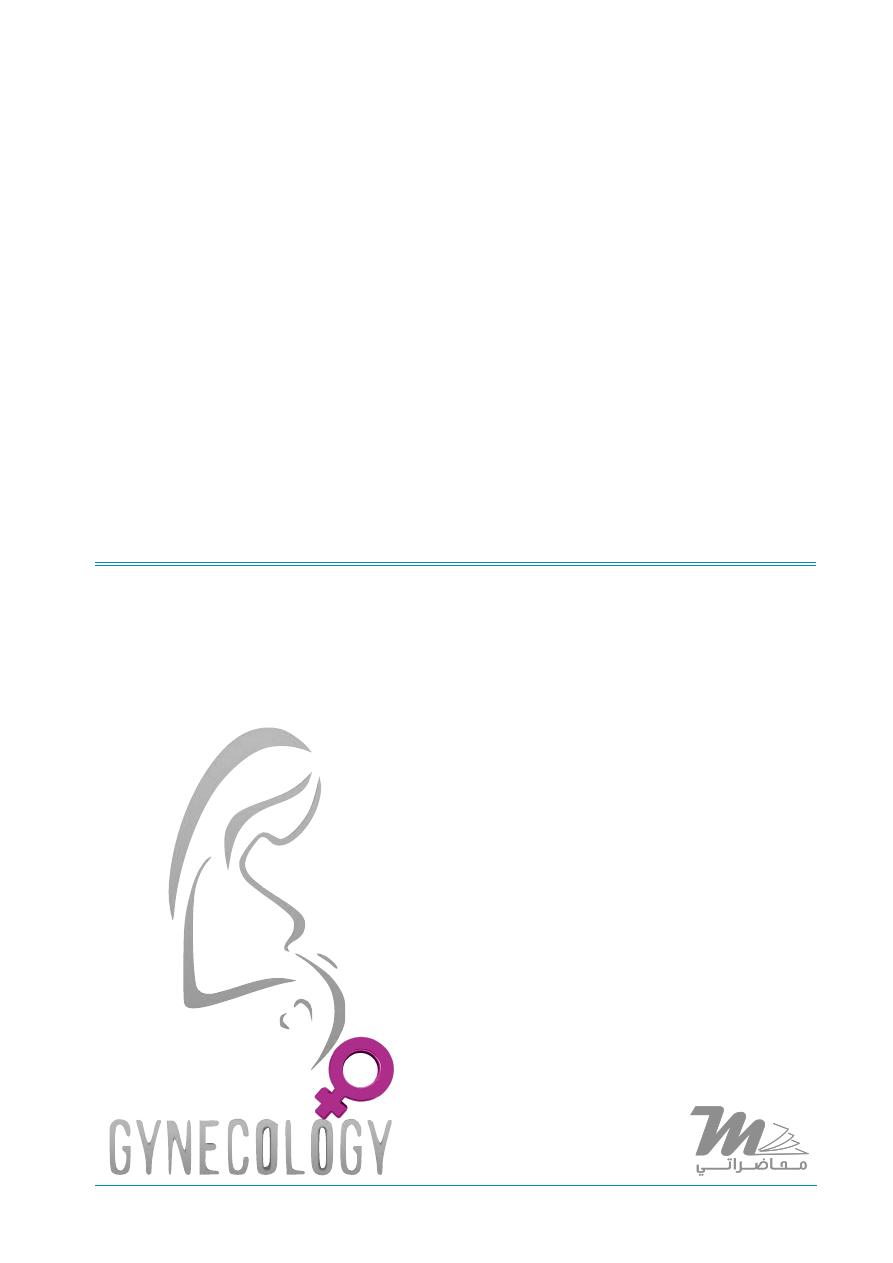
AFTER MID
TOTAL LEC: 30
Gynaecology
Dr. Shaima’a Kadhim Al-Khafaji
Lec 30 - Urogynecological Conditions
DR. SHAIMA’A - LEC 2
مكتب املدينة


Urogynecological conditions
(Urinary incontinence, voiding difficulties, and prolapse)
URINARY INCONTENENCE
It is defined as involuntary loss of urine that is objectively
demonstrable. It is regarded as a social as well as hygienic problem.
Its incidence increases with age: it occurs in 5% of women below the
age of 45 yrs, 10% of women above the age of 45 yrs and 20% of women
above the age of 65 yrs.
Common symptoms associated with incontinence
1) Stress incontinence (which is a symptom and a sign) means loss of
urine upon eliciting a physical effort. It is not a diagnosis.
2) Urgency means a sudden desire to void. Urge incontinence is an
involuntary loss of urine associated with a strong desire to void.
3) Overflow incontinence occurs without any detrusor muscle
activity when the bladder is over distended.
4) Frequency is defined as the need to pass urine seven or more
times a day, or be awakened from sleep more than once at night
to void.
5) In addition, women may complain of prolapse or sexual
dysfunction due to the present leakage and coexisting anal
incontinence.

Classification of incontinence
Urethral causes:
§
urethral sphincter incompetence (urodynamic stress incontinence)
§
Detrusor over-activity or the unstable bladder- this is either
neurogenic or non neurogenic
§
retention with overflow
§
Congenital causes
§
Miscellaneous
Extra urethral causes:
(congenital causes)
§
Bladder exstrophy and ectopic ureter
§
fistula
Urethral causes
1. Urodynamic stress incontinence:
is defined as the involuntary leakage of urine during increased
abdominal pressure in the absence of a detrusor muscle contraction.
Previously called genuine stress incontinence, and is noted during
filling cystometry.
Symptoms:
•
Stress incontinence is the usual symptom but urgency, frequency
and urge incontinence may also be present.
•
The patient may be aware of an associated prolapse.
•
On clinical examination, it can be demonstrated when the patient
coughs.

Etiology
•
Damage to the nerve supply of the pelvic floor and urethral
sphincter following childbirth leads to progressive changes in
these structures resulting in altered function.
•
Menopause and associated tissue atrophy
•
Congenital cause in some nulliparous due to altered connective
tissue structure
•
Chronic cause such as obesity, chronic obstructive pulmonary
disease and constipation.
Pathophysiology
1) Abnormal descent of the bladder neck and proximal urethra,
hence there is unequal transmission of the intra-abdominal
pressure on the proximal urethra, leading to the reversal of the
normal pressure gradient between the bladder and urethra,
with a resultant negative urethral closure pressure.
2) The intraurethral pressure at rest is lower than the
intravesical pressure, this may be due to urethral scarring as a
result of surgery or radiotherapy. It also occurs in older women
due to estrogen deficiency.
3) laxity of suburethral support (which is normally provided by
the vaginal wall, endopelvic fascia, arcus tendineus fascia and
Levator ani muscles acting as a single unit) results in
ineffective compression during physical stress and consequent
incontinence.

2. Detrusor overactivity
Previously called detrusor instability, is a urodynamic observation
characterized by involuntary detrusor contractions during the filling
phase which may be spontaneous or provoked.
Symptoms
•
The combination of urgency, frequency and nocturia with or
without urgency incontinence and in the absence of urinary
tract infection is termed the overactive bladder syndrome.
•
During examination, any mass that can cause compression of
the bladder must be excluded and prolapse must be examined
for.
•
If there is vaginal atrophy, this may also cause some urgency
and frequency.
Pathophysiology
•
Poor toilet habit training and psychological factors may be
predisposing factors, more recently UTI was proposed to be a
triggering factor.
•
An idiopathic variety is more prevalent after menopause.
childhood enuresis increases the likelihood of overactive
bladder
•
Neuropathy appears to be a risk factor
•
Incontinence surgery, outflow obstruction and smoking are
also associated.
3. Retention with overflow:
Insidious failure of bladder empting may lead to chronic retention
and finally, when normal voiding is ineffective, overflow
incontinence.

Symptoms
• manifests as incomplete bladder emptying and straining to
void, poor stream together with overflow stress incontinence.
• Cystometry is usually required to make the diagnosis, bladder
ultrasonography or intravenous urogram may be also
necessary.
Etiology
•
Lower motor or upper motor neuron lesions.
•
Urethral obstruction
•
pharmacological
4. Congenital:
Epispadias, which is due to faulty midline fusion of mesoderm,
results in a widened bladder neck, shortened urethra, separation of
the symphysis pubis and imperfect sphincter control.
5. Miscellaneous:
Acute urinary tract infection or faecal impaction in the elderly may
lead to temporary incontinence.
Extra urethral causes
Congenital:
1. Bladder exostrophy and ectopic ureter:
There is failure of
mesodermal migration with breakdown of ectoderm and endoderm,
resulting in absence of the anterior abdominal wall and anterior bladder
wall.
2- fistula:
is an abnormal opening between the urinary tract and the
outside.

INVESTIGATIONS
o Midstream urine specimen
o Urinary diary: is a simple record of patients' fluid intake and
output. Episodes of urgency, leakage and the precipitating events
are also recorded for 3-5 consecutive days.
o Pad test: Are used to verify and quantify urine loss. The
international continence society pad test takes 1 hour, the patient
wears a pre-weighed sanitary towel, drinks 500 ml of water and
rests for 15 min. After a series of defined maneuvers, the pad is
reweighed; a urine loss of more than 1g is considered significant.
UROFLOMETRY
Is the measurement of urine flow rate. It is a simple, non invasive,
outpatient test, the normal flow curve is bell shaped.
A flow rate <15 ml / second on more than one occasion is
considered abnormal in females. The voided volume should be >150 ml ,
in volumes less than that, the measured flow rates are considered not
reliable. A low peak rate and a prolonged voiding time suggest a
voiding disorder.
CYSTOMETRY
it is the most fundamental investigation. It involves the
measurement of the pressure-volume relationship of the bladder.
It includes simultaneous abdominal pressure recording in addition
to intravesical pressure monitoring during bladder filling and voiding.
Electronic subtraction of abdominal from intravesical pressure enables
determination of the detrusor muscle pressure.
the intravesical pressure is measured using a catheter, at the
same time another catheter is inserted into the rectum to measure the
intra abdominal pressure. During filling, the patient is asked to indicate
her first and maximal desire to void and these volumes are noted.

THE PARAMETERS OF NORMAL BLADDER FUCTION
ü
Residual urine of <50 ml
ü
First desire to void between 150 and 200ml
ü
Capacity between 400 and 600 ml
ü
Detrusor pressure rise of <15 cmH2O during filling and standing.
ü
Absence of systolic detrusor contractions.
ü
No leakage on coughing.
ü
A voiding detrusor pressure rise of <70 cmH2O with a peak flow
rate of >15 ml/second for a volume >150 ml.
o Videocystourethrography: if a radio-opaque filling medium is
used during cystometry, the lower urinary tract can be visualized
by x-ray screening with an image intensifier.
o Intravenous urography: little information but indicated in
heamaturia, neuropathic and fistula.
o Ultrasound: becoming more widely used in urogynaecology.
o Magnetic resonance imaging: produces anatomical pictures of
pelvic floor
o Cystourethroscopy: establishes the presence of disease in the
urethra or bladder.
o Urethral pressure profilometry: to maintain continence, the
urethral pressure must remain higher than the intravesical
pressure
o Ambulatory monitoring: fine micro tip transducers are inserted
into the bladder and rectum

TREATMENT
•
Prevention
•
Conservative management: physiotherapy is the mainstay of the
conservative treatment in stress incontinence.
•
Surgery: the aims of surgery are:
i.
t
o provide suburethral support
ii. restoration of the proximal urethra and bladder neck to the
zone of intra-abdominal pressure transmission.
iii. to increase urethral resistance
iv. a combination of both.
The colposuspension operation used to be considered the gold standard
for stress incontinence. But after the introduction of tension-free vaginal
tape (TVT) the popularity of the colposuspension has waned.
TVT procedure involves the placement of a polypropylene tape
under the midurethra through a single 1-2cm anterior vaginal incision
wall and two suprapubic 0.5cm incisions approximately 4-5 cm apart.
A needle introducer is passed on either side of the urethra
through the vagina incision and passed through the retropubic space to
emerge through the ipsilateral suprapubic incision.
Modifications of the TVT have involved a departure from the
retropubic approach to the external incisions being made lateral to the
labia over the obturator foramina bilaterally (TOT).
Single incision tapes are evolving, here the tapes are inserted
through a vaginal incision and attached to either the obturator internus
muscle or into the obturator membrane.

The artificial sphincter is used when the conventional surgery has
failed. Periurethral bulking agent: contigen collagen is ususally injected
paraurethrally and Macroplastique transurethrally
Evidence-based medicine has shown TVT and colposuspension to be the
most widely practiced and most effective operation for stress
incontinence.
The anterior repair and endoscopic bladder neck suspension are NOT
good operations in the medium or long term effect for this condition.
DTRUSOR OVERACTIVITY can be treated by bladder retraining
biofeedback or hypnosis.
Anticholinergic agents, such as oxybutynin 2.5 mg twice daily or
tolterodine 2 mg twice daily also can be used. sacral nerve stimulator
offers another alternative.
Botulinum toxin injections under cystoscopic control into the detrusor
muscle are being used for women with detrusor overactivity.

